Welcome to the wonderful world of red birds in Arkansas! Arkansas is home to various colorful birds, including the American Redbird. These beautiful creatures are a breathtaking sight to behold in the wild.
Redbirds can be found throughout the Natural State, from the wooded Ozark Mountains to the wide-open fields of the Delta. From the bright crimson of the male Scarlet Tanager to the subtle pink of the female Painted Bunting, there’s a red bird for every bird watcher.
Whether you’re looking for a bird to watch from your backyard or a chance to see these feathered friends in their natural habitat, Arkansas has plenty to offer. Learn more about the different species of red birds in Arkansas and how to enjoy them best.
23 Red Birds In Arkansas
The state of Arkansas, nestled within the heart of the United States, boasts a rich tapestry of natural beauty and diverse ecosystems. Among its many natural treasures, the avian population is a testament to the region’s biodiversity.
Here are 23 Red Birds In Arkansas.
1. House Finch
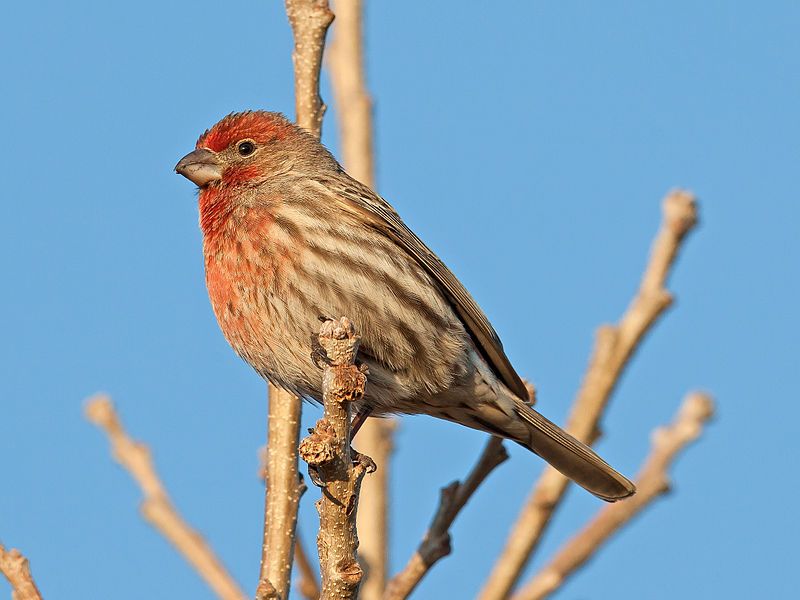
The house finch is a type of bird belonging to the Fringillidae family, which consists of true finches. It is native to Western North America, and its range has been expanding to the continent’s East Coast and Hawaii.
This species is also included in the genus Haemorhous and two other American rosefinches. This genus is characterized by its red coloration, so they are often referred to as “redfinches.”
The house finch is a small bird, averaging between 5.5 to 6.7 inches long, with a wingspan of about 8 to 10 inches. It has a brownish-red head and chest, with grayish-brown wings and tail.
Its diet consists mainly of seeds and other plant materials and will also eat insects and fruits. It is often seen in urban areas, where it can be found perched on feeders and rooftops.
The house finch is an integral part of the North American ecosystem, as it plays a role in pollination and seed dispersal.
| Kingdom | Animalia |
| Phylum | Chordata |
| Class | Aves |
| Order | Passeriformes |
| Family | Fringillidae |
| Genus | Haemorhous |
| Species | H. mexicanus |
2. Northern Cardinal
The northern cardinal is a beautiful species of bird that is often referred to by a variety of names. It is commonly known as the ‘redbird’ but is also called the ‘common cardinal,’ ‘red cardinal,’ or simply ‘cardinal.’
This bird is scientifically classified under the genus’ Cardinalis’. It is easily recognizable due to its bright red color, the source of its various nicknames. The male northern cardinal is incredibly and stands out in its environment.
Its diet comprises various seeds and insects, easily found in forests, gardens, and backyards. Northern cardinals are found in the east and midwest of the United States, where they are a famous sight and a source of joy for many.
They are also found throughout Central America and in parts of the Caribbean. The northern cardinal is an integral part of the ecosystem and is a beloved bird for many.
| Kingdom | Animalia |
| Phylum | Chordata |
| Class | Aves |
| Order | Passeriformes |
| Family | Cardinalidae |
| Genus | Cardinalis |
| Species | C. cardinalis |
3. Summer Tanager
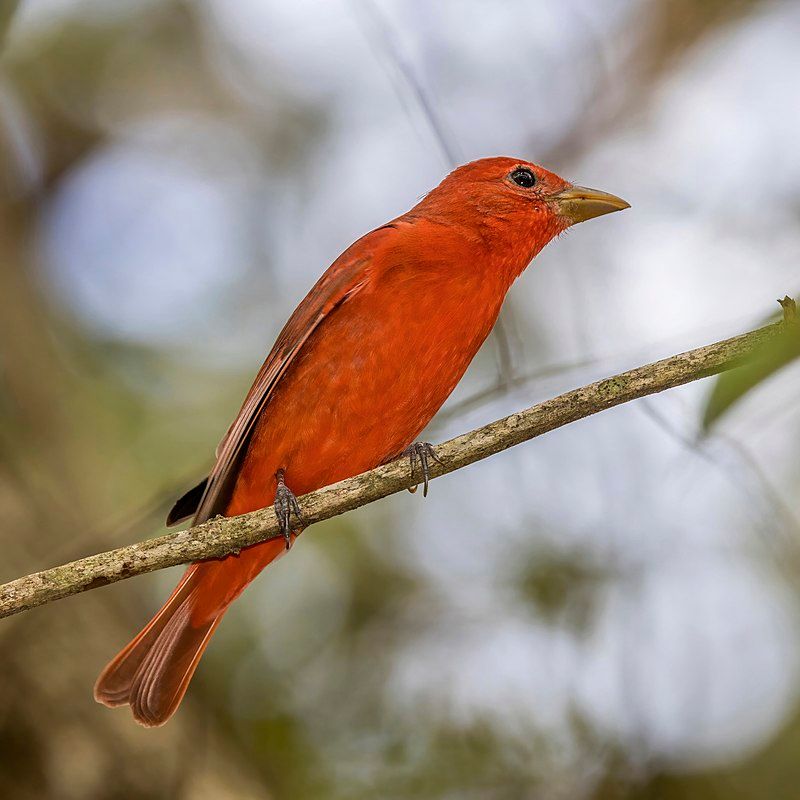
The summer tanager is a medium-sized songbird native to North America. It was previously classified as a member of the tanager family but is now placed in the cardinal family along with other members of its genus.
The summer tanager has plumage and vocalization similar to other members of the cardinal family but can be identified by its bright yellow body and reddish-orange wings and tail. The male is more brightly colored than the female.
Its song is a sweet, unmistakable warble that is often heard during the summer months. Its diet consists mainly of insects but eats some fruits and berries. The summer tanager is an integral part of the North American ecosystem, helping to keep insect populations in check.
| Kingdom | Animalia |
| Phylum | Chordata |
| Class | Aves |
| Order | Passeriformes |
| Family | Cardinalidae |
| Genus | Piranga |
| Species | P. rubra |
4. Scarlet Tanager
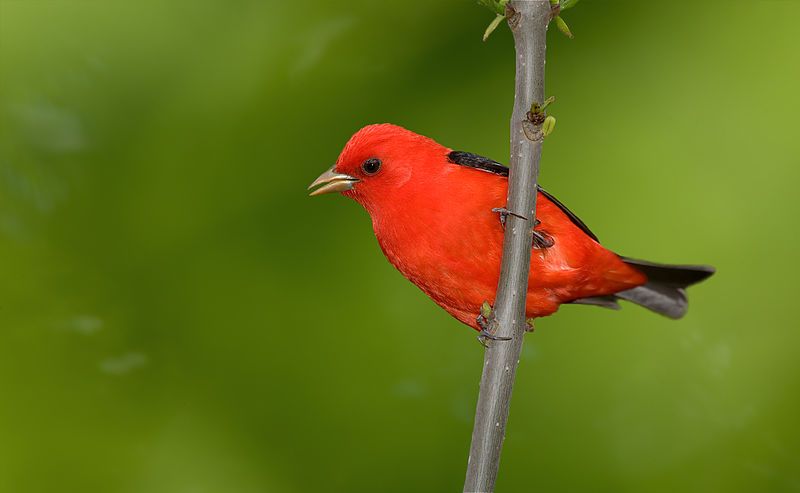
The scarlet tanager is a colorful bird native to North America. It is a medium-sized songbird, growing to around six or seven inches in length.
Until recently, it was classified as a tanager, or Thraupidae, a family of small to medium-sized birds found throughout the Americas. However, recent studies have reassigned this species to the cardinal family or Cardinalidae.
This family comprises birds generally found in North and South America with a distinct red plumage. The scarlet tanager is no exception, with its bright red and black feathers. The tanager is an important species, playing a vital role in the local ecosystem.
It feeds on insects and fruit and is a critical species in the food web of its habitat. In addition, it is also a famous bird for birdwatchers, who can easily spot it in its native woodlands.
| Kingdom | Animalia |
| Phylum | Chordata |
| Class | Aves |
| Order | Passeriformes |
| Family | Cardinalidae |
| Genus | Piranga |
| Species | P. olivacea |
5. Painted Bunting
The painted bunting is a species of bird that belongs to the cardinal family, Cardinalidae. Native to North America, its most striking feature is the bright plumage of the male. However, this is not visible until the bird is in its second year.
During the first year, the only way to distinguish a male from a female is through close inspection. The painted bunting is a colorful bird to observe in its natural habitat, and its unique plumage makes it stand out from other species of birds.
| Kingdom | Animalia |
| Phylum | Chordata |
| Class | Aves |
| Order | Passeriformes |
| Family | Cardinalidae |
| Genus | Passerina |
| Species | P. ciris |
6. Red Crossbill
The red crossbill is a small bird that belongs to the finch family Fringillidae. It is known for its distinctive mandibles, crossed at the tips. This helps the bird to extract seeds from conifer cones and other fruits.
This adaptation gives the crossbill a unique advantage over other birds, allowing it to get the nutrition it needs from sources inaccessible to other birds.
The red crossbill has a wide range, as it is found in the United States, Canada, Europe, Siberia, and parts of Asia. It is a migratory bird, moving south during winter and returning to its nesting grounds in the north in summer.
The red crossbill feeds on a variety of seeds, fruits, and buds, as well as insects and spiders. The red crossbill is a social bird, living in large flocks and nesting in coniferous forests. It is a vocal bird with various calls, chirps, and trills.
The red crossbill has a red-brown body and a yellow-red head, with a black stripe running through the eye.
The wings and tail are black and white, and the underparts are white. The red crossbill is a valuable species in the ecosystem, as it disperses seeds from conifer cones that it feeds on. This helps to increase biodiversity and helps to maintain healthy forests.
The red crossbill is also essential for birdwatchers and photographers, as it is a beautiful and unique species.
| Kingdom | Animalia |
| Phylum | Chordata |
| Class | Aves |
| Order | Passeriformes |
| Family | Fringillidae |
| Genus | Loxia |
| Species | L. curvirostra |
7. Pine Grosbeak
The pine grosbeak is a species of bird that belongs to the true finch family, Fringillidae. It is the only bird in its genus, Pinicola.
This species is native to coniferous woodland regions across Alaska, the western United States, Canada, and subarctic Fennoscandia and across the Palearctic to Siberia.
They are considered quite large, and their coloring ranges from bright red to light grey. They are known for their sweet, flute-like song, which they sing during breeding season.
These birds mainly feed on seeds and berries, which they find in the coniferous woods and shrublands where they prefer to live. They also eat insects and other invertebrates and are known to be quite bold when stealing food from people’s bird feeders.
During winter, they often form large flocks and travel great distances to find food. Pine grosbeaks are pretty social birds frequently seen in pairs or small groups. They are monogamous and mate for life.
The female builds the nest and incubates the eggs, while the male provides food for her and the chicks. These birds have a relatively long lifespan, with some known to live up to 13 years.
The pine grosbeak is a beautiful bird with an exciting range of habitats and behaviors. These birds make an excellent addition to any backyard and can be seen throughout the year in many parts of North America.
| Kingdom | Animalia |
| Phylum | Chordata |
| Class | Aves |
| Order | Passeriformes |
| Family | Fringillidae |
| Genus | Pinicola |
| Species | P. enucleator |
8. Two-Barred Crossbill
The two-barred crossbill is a small passerine bird species in the finch family. It is found in North America and the Palearctic region, spanning Europe, Asia, and Northern Africa.
This bird species is characterized by its distinctive two-barred pattern on its feathers and white-winged appearance. The two-barred crossbill is a highly specialized bird species in coniferous forests.
This species is adapted to feed on the seeds of conifers, such as those of spruce, pine, and larch, which are well-protected in the cones of these trees. They use their specialized beaks to pry open the cones and access the seeds within.
The two-barred crossbill is an integral part of the ecosystem as it helps to disperse the seeds of conifers, ensuring the regeneration of these forests.
This bird species is also an indicator species, meaning that the health of the coniferous forests is closely linked to the presence of two-barred crossbills. Changes in their population can indicate changes in the health of these forests.
The two-barred crossbill is an exciting bird species essential to North America’s coniferous forests and the Palearctic region. Its specialized diet and behavior help ensure these forests’ continued regeneration.
| Kingdom | Animalia |
| Phylum | Chordata |
| Class | Aves |
| Order | Passeriformes |
| Family | Fringillidae |
| Genus | Loxia |
| Species | L. leucoptera |
9. Red-Headed Woodpecker

The red-headed woodpecker is a type of bird found in the temperate climates of North America. It is classified as a mid-sized woodpecker, meaning that it is of average size compared to other woodpeckers.
The woodpecker is found across southern Canada and the east-central United States, where it makes its home in open fields and other open areas. This bird species is famous in these areas, often seeking food and shelter in the trees.
The red-headed woodpecker is a valuable ecosystem member, providing many environmental benefits. It plays a crucial role in controlling insect populations, helping to keep the balance of nature in check.
Additionally, it is an integral part of the food chain, providing sustenance to larger animals such as hawks and owls.
The red-headed woodpecker is an integral part of the environment, and it is essential to protect its breeding habitat and ensure that it can continue to thrive in its natural environment.
| Kingdom | Animalia |
| Phylum | Chordata |
| Class | Aves |
| Order | Piciformes |
| Family | Picidae |
| Genus | Melanerpes |
| Species | M. erythrocephalus |
10. Common Redpoll
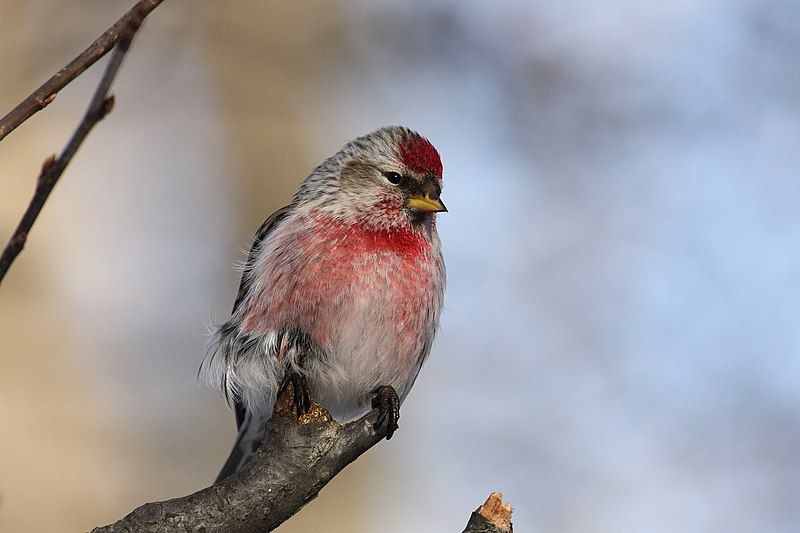
The common redpoll, or mealy redpoll, is a type of bird that belongs to the finch family. It is a species of bird often found in the world’s northern regions, and it breeds mainly in areas located further south than the Arctic redpoll.
This bird species usually inhabits areas with plenty of shrubs and thickets, providing a safe environment for it to nest and feed. The common redpoll is a small, sparrow-sized bird with a bright red forehead and a grey-brown back.
It generally prefers to feed on seeds, insects, and tree buds. The male common redpoll has a reddish-brown breast and a white belly, while the female has a duller brown breast and belly.
The male common redpoll develops a yellowish-orange head and throat during the breeding season. The common redpoll is a very social bird, often found in flocks comprised of many individuals.
It is known to migrate southward during winter when food sources are scarce. This species is also quite vocal, producing a variety of squeaks and chirps to communicate with other birds.
| Kingdom | Animalia |
| Phylum | Chordata |
| Class | Aves |
| Order | Passeriformes |
| Family | Fringillidae |
| Genus | Acanthis |
| Species | A. flammea |
11. Red-bellied woodpecker
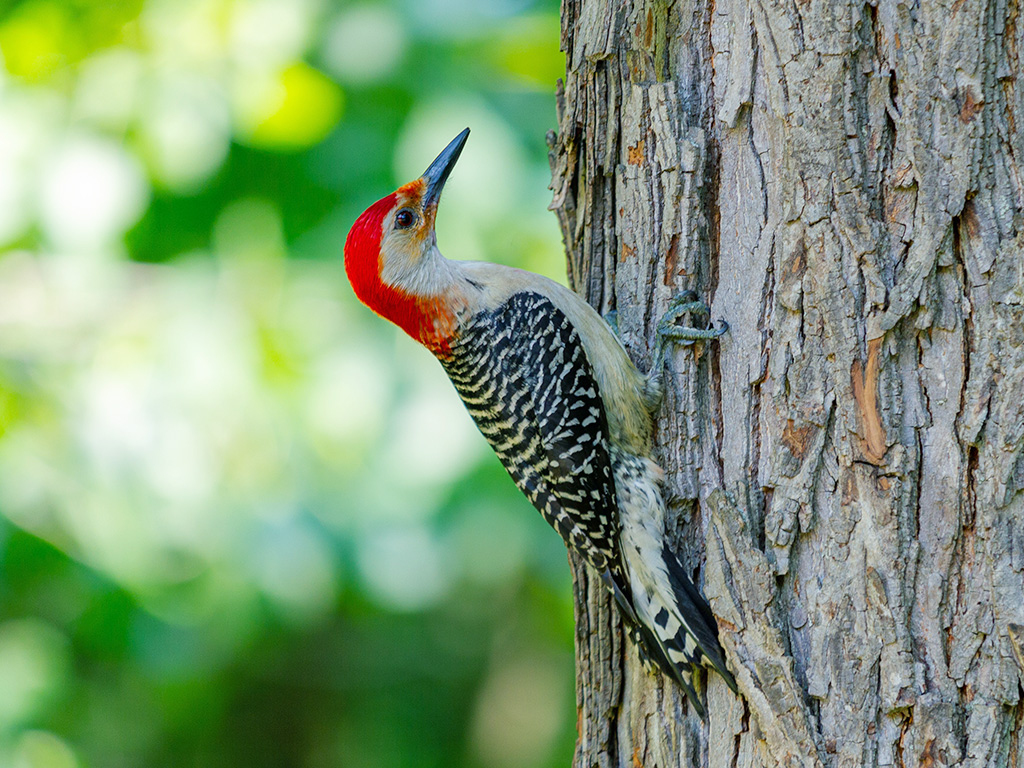
The red-bellied woodpecker is a type of bird in the Picidae family. It is a medium-sized woodpecker found mainly in the eastern United States. Its range extends from Florida in the south, all the way up to Canada in the north.
This species is the only woodpecker species found in both the United States and Canada. It has a distinctive red belly, which can be seen easily when the bird is in flight. The red-bellied woodpecker is common in wooded areas and is most active during the day.
It feeds mainly on insects, nuts, and berries, which it obtains by drilling into tree bark. The red-bellied woodpecker is often found in pairs or small groups and builds its nest in a hole in a tree trunk.
During breeding season, the female will lay between three and seven eggs and both parents will incubate the eggs.
Once the eggs have hatched, both parents will feed and care for the hatchlings until they are ready to leave the nest. The red-bellied woodpecker is a fascinating species and an essential part of the ecosystem in the eastern United States.
Its range makes it a great species to watch for bird enthusiasts in both the United States and Canada.
| Kingdom | Animalia |
| Phylum | Chordata |
| Class | Aves |
| Order | Piciformes |
| Family | Picidae |
| Genus | Melanerpes |
| Species | M. carolinus |
12. Rose-Breasted Grosbeak
The rose-breasted grosbeak is a species of finch native to North America that has earned the nickname “cut-throat” due to its unique coloration. It is a large bird that belongs to the Cardinal family and primarily feeds on seeds and other small fruits.
Males have a distinctive black head, wings, back, and tail, with a bright rose-colored patch on their white breast. The rose-breasted grosbeak is an agile bird and an expert foliage gleaner, meaning it can search through the foliage of trees to find food.
This bird is an essential part of the North American ecosystem and is a beloved sight for many birdwatchers.
| Kingdom | Animalia |
| Phylum | Chordata |
| Class | Aves |
| Order | Passeriformes |
| Family | Cardinalidae |
| Genus | Pheucticus |
| Species | P. ludovicianus |
13. Ruby-Throated Hummingbird
The ruby-throated hummingbird is a species of hummingbird that is known for its long-distance migration patterns. It is mainly found in Central America, Mexico, and Florida during the winter months.
However, when the summer arrives, the hummingbird begins its journey to Canada and other parts of Eastern North America, where it goes to breed. This species of hummingbird can travel over two thousand miles during its migration.
A diet of nectar and insects fuels its remarkable long-distance flight. It is also known to rest and feed at various stops along its journey to conserve energy.
The ruby-throated hummingbird is an impressive species, as it can migrate extended distances and suitable areas to breed and raise their young.
| Kingdom | Animalia |
| Phylum | Chordata |
| Class | Aves |
| Clade | Strisores |
| Order | Apodiformes |
| Family | Trochilidae |
| Genus | Archilochus |
| Species | A. colubris |
14. Eastern Towhee
The eastern towhee is a large species of sparrow native to the New World. It is one of two species of towhee, the other being the spotted towhee, formerly considered one species known as the rufous-sided towhee.
In recent decades, the debate has swirled around the taxonomy of the towhees, with some scientists arguing for the recognition of two distinct species—the eastern towhee breeds in brushy habitats across eastern North America.
The bird’s preferred habitat is thick vegetation that provides plenty of cover from potential predators. Other essential components of the bird’s habitat include a plentiful food supply and access to water.
The eastern towhee is a ground-feeding species and relies on seeds, insects, and other invertebrates for sustenance. The east towhee is also an aggressive species, often chasing away other birds from its territory.
| Kingdom | Animalia |
| Phylum | Chordata |
| Class | Aves |
| Order | Passeriformes |
| Family | Passerellidae |
| Genus | Pipilo |
| Species | P. erythrophthalmus |
15. Red-Shouldered Hawk
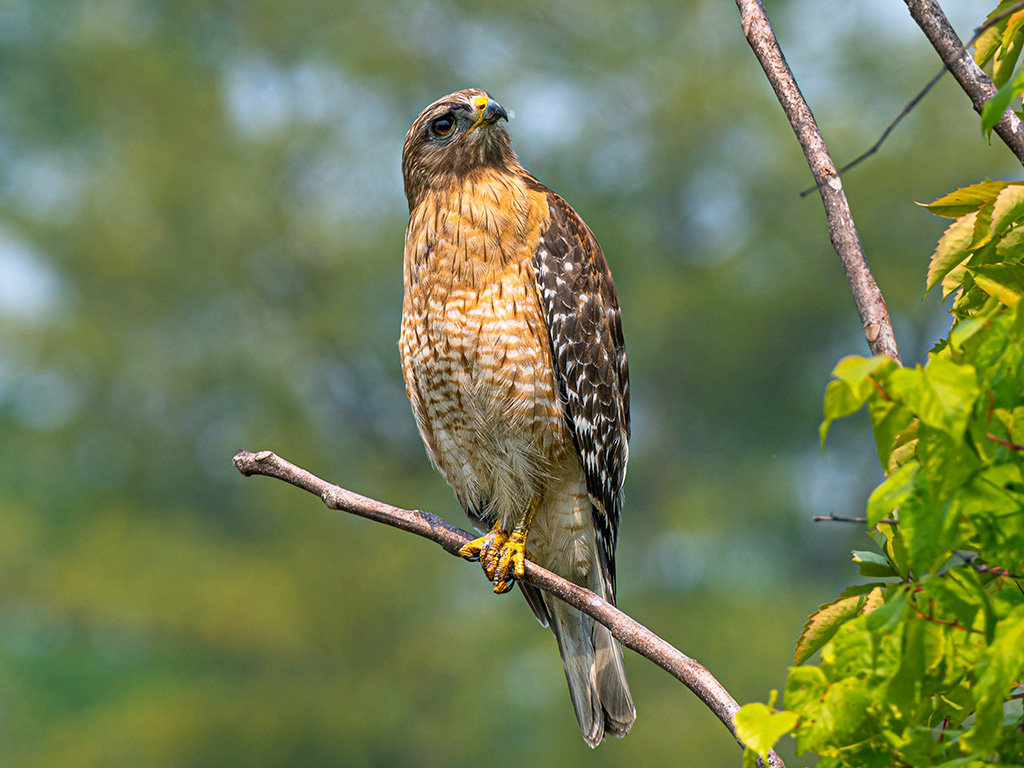
The red-shouldered hawk is a type of medium-sized raptor, or bird of prey, of the Buteo genus. It is found across a wide range of eastern North America, from Canada to the United States and as far south as Mexico.
In California, it is found along the coast and in northern and northeastern-central Mexico. The red-shouldered hawk is a permanent resident of its range, meaning it does not migrate.
The only exceptions are in the northern parts of its range, where the birds migrate to central Mexico during the winter.
| Class | Aves |
| Order | Accipitriformes |
| Family | Accipitridae |
| Genus | Buteo |
| Species | B. lineatus |
16. Northern Flicker
The northern flicker (also known as the familiar flicker) is a member of the woodpecker family and is a medium-sized bird. It is native to most of North America, parts of Central America, Cuba, and the Cayman Islands.
This makes it one of the woodpecker species that can migrate over more considerable distances than other species. The northern flicker is known for its distinct red-shafted feathers and yellow-shafted feathers. The northern flicker is a solitary species, often seen alone.
It is an omnivore, and its diet consists of insects, fruits, nuts, and seeds. It also has an interesting courtship ritual, with males tapping on trees and other objects to attract a mate. Its call is a distinctive “flick-a, flick-a” sound.
The northern flicker is an integral part of the North American bird population, providing many benefits to the local ecosystem.
| Kingdom | Animalia |
| Phylum | Chordata |
| Class | Aves |
| Order | Piciformes |
| Family | Picidae |
| Genus | Colaptes |
| Species | C. auratus |
17. Red-Breasted Nuthatch
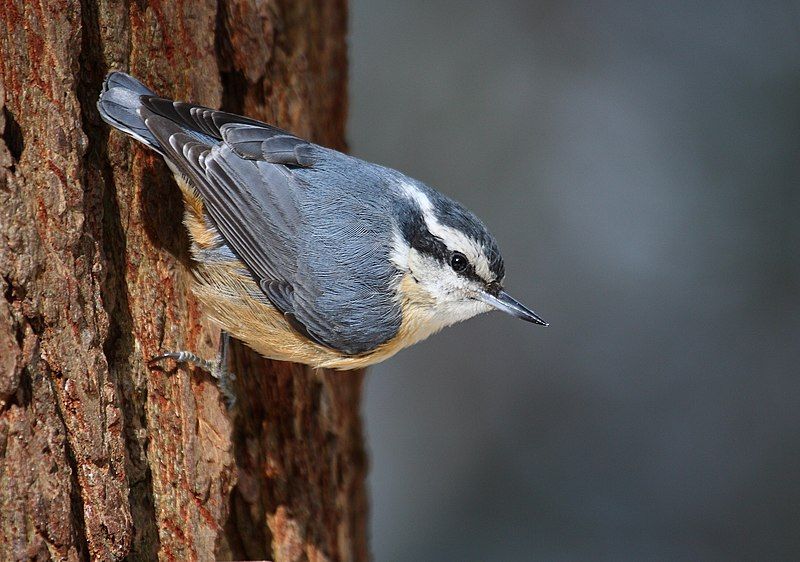
The red-breasted nuthatch is a small songbird with distinctive coloring. It has blue-grey upperparts and cinnamon underparts, with a white face and throat. A black stripe runs through the eyes, and the bird has a straight grey bill and a black crown.
Its call is unique – some have likened it to a tin trumpet, as it is high-pitched and nasal. It is a distinctive sound that can be heard in many parts of North America.
The red-breasted nuthatch lives in wooded areas, often climbing up tree trunks and branches in search of insects and seeds. It is an active bird known for its acrobatic flying skills. It is a social bird, often seen in flocks or pairs.
The red-breasted nuthatch is an important species for conservation, as it plays a vital role in the environment’s health by helping to disperse seeds and keep insect populations in check.
As human activities threaten its habitat, conservation efforts are needed to ensure the continued survival of this species.
| Kingdom | Animalia |
| Phylum | Chordata |
| Class | Aves |
| Order | Passeriformes |
| Family | Sittidae |
| Genus | Sitta |
| Species | S. canadensis |
18. Downy Woodpecker
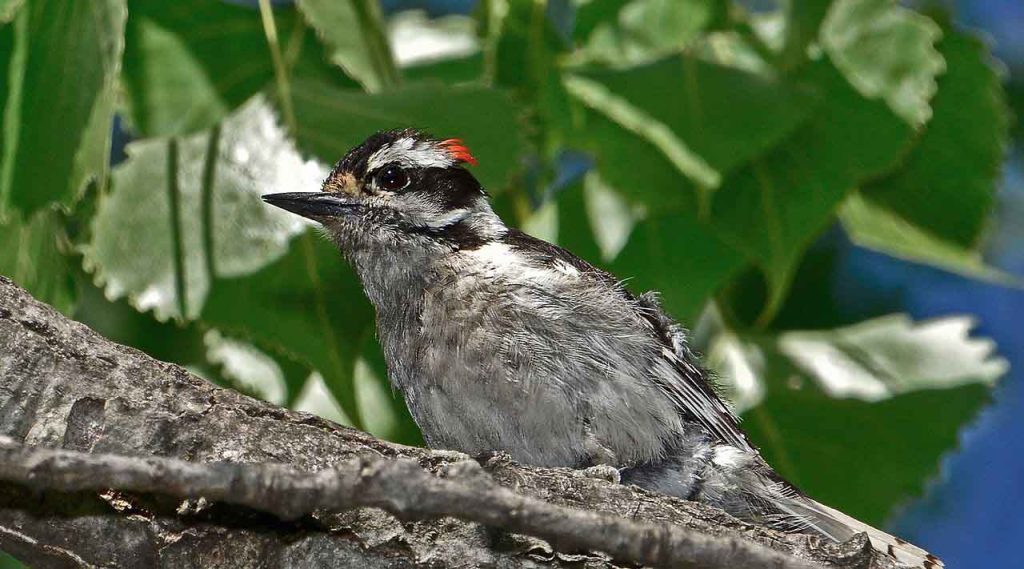
The Downy Woodpecker is a species of woodpecker native to North America. It is the smallest species of woodpecker, ranging in size from 14 to 18 cm in length.
These birds are found throughout the United States and Canada but have a limited presence in the southwest and northern tundra desert regions. They prefer living in forested areas since this provides adequate resources for survival.
Downy woodpeckers feed primarily on insects and grubs, which they find in trees or on the ground. They also eat nuts, fruit, and seeds.
They can peck through bark and wood to locate these items and are integral in keeping insect populations under control in their habitats. Downy woodpeckers are known for their vocalizations, consisting of various calls and songs.
These vocalizations are usually heard during the mating season when the birds actively search for a mate. They can also be heard during territorial disputes when two males compete for a female.
The Downy Woodpecker is a fascinating species that plays a vital role in its environment. Its ability to peck through wood helps to keep insect populations in check, while its vocalizations provide a unique audio experience.
| Kingdom | Animalia |
| Phylum | Chordata |
| Class | Aves |
| Order | Piciformes |
| Family | Picidae |
| Genus | Dryobates |
| Species | D. pubescens |
19. Red-Winged Blackbird
The Red-winged Blackbird is a beautiful bird in many parts of the world. It is a type of passerine bird, part of a bird family called Icteridae.
They are found mainly in North America and Central America but also in other parts of the world, such as Europe and Asia. Their black feathers and red and yellow wing patches often identify these birds.
The males have the most colors and are often seen perched on fence posts or singing from the highest branches of trees.
The females are more dull in color and blend in with their environment. Red-winged blackbirds are omnivores and feed on various insects, berries, and seeds. They also feed on other small animals, such as frogs and mice.
They build their nests in marshes and wetlands, which provide them with plenty of food and protection from predators.
The red-winged blackbird is an integral part of the ecosystem as it helps control insect populations and spreads the seeds of plants, which helps spread vegetation.
They are also crucial to many cultures, who view them as symbols of freedom and independence.
| Kingdom | Animalia |
| Phylum | Chordata |
| Class | Aves |
| Order | Passeriformes |
| Family | Icteridae |
| Genus | Agelaius |
| Species | A. phoeniceus |
20. Pileated Woodpecker
The pileated woodpecker is a large, mostly black bird found in North America, particularly in the eastern parts of the continent, the Great Lakes region, and Canada’s boreal forests. This woodpecker is an insectivore, which means it feeds mainly on insects.
The pileated woodpecker typically inhabits deciduous forests, where the trees shed their leaves in autumn. It is also found in parts of the Pacific Coast in North America.
The pileated woodpecker is recognizable for its distinctive red crest on the head and its loud, drumming call. It is about the size of a crow, with a long beak and neck. The wingspan of this bird is about 15 to 19 inches.
The males have a red patch on the cheek, whereas the females have a black patch. This woodpecker species can be seen hammering away at dead trees and logs, looking for insects. It uses its long beak to peck away at the wood to find food.
The pileated woodpecker also excavates large, rectangular holes in trees to create nests. The pileated woodpecker is an integral part of North American ecosystems. It helps control insect populations and disperse tree seeds.
It also serves as an indicator species, which means its presence or absence can tell us about the health of the ecosystem it inhabits.
| Kingdom | Animalia |
| Phylum | Chordata |
| Class | Aves |
| Order | Piciformes |
| Family | Picidae |
| Genus | Dryocopus |
| Species | D. pileatus |
21. Red-Eyed Vireo
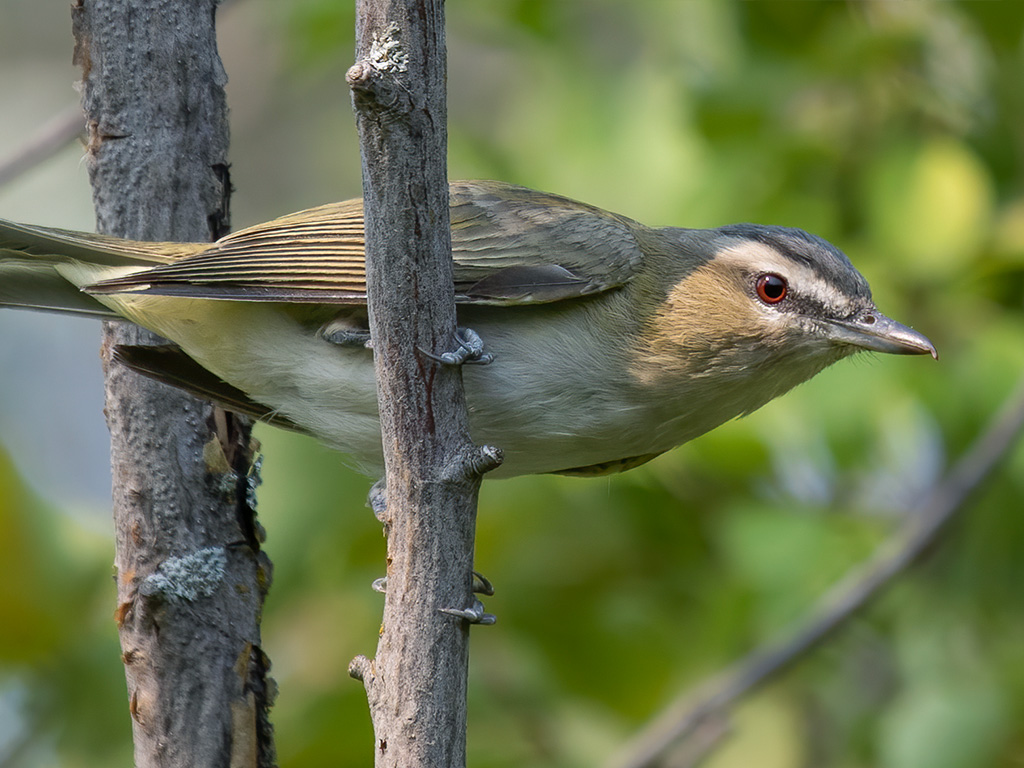
The red-eyed vireo is a small American songbird distinct from the New World warblers. It is found in a wide range of habitats and is quite common in those habitats. Its range is quite extensive, stretching from Canada to the Caribbean.
The red-eyed vireo is not considered threatened by the International Union for Conservation of Nature (IUCN) due to its abundance and wide distribution. This species is noted for its bright white underparts, olive-green upperparts, and red eyes.
Its diet consists mainly of insects, berries, and other fruits, and it prefers to forage in the middle and upper levels of trees. The red-eyed vireo is known for its melodic, whistled songs heard throughout the breeding season.
Although the red-eyed vireo is not considered threatened, its population is declining due to habitat destruction and fragmentation. Conservation efforts are needed to ensure the long-term survival of this species.
| Kingdom | Animalia |
| Phylum | Chordata |
| Class | Aves |
| Order | Passeriformes |
| Family | Vireonidae |
| Genus | Vireo |
| Species | V. olivaceus |
22. Red-Cockaded Woodpecker
The red-cockaded woodpecker is an endangered species native to the southeastern United States. It is the only species of woodpecker in the United States listed as endangered and found in only a few areas in the south.
The bird is easily recognized by its black body, white stripes on the wings, and red streaks on the sides of its head. This species of woodpecker depends heavily on mature pine forests for its survival.
They are often found in stands of longleaf pine with dense undergrowth of shrubs and small trees. These forests provide the birds with the food sources they need, such as insects, and the cavities they need for nesting and roosting.
The red-cockaded woodpecker also relies on the presence of large, old trees for nesting, roosting, and foraging. The red-cockaded woodpecker faces numerous threats to its survival, including habitat loss and fragmentation, predation, and competition from other species.
As forests are cleared for development, these birds lose access to the habitat they need to survive.
Additionally, the presence of non-native species, such as European Starlings, can outcompete the woodpeckers for resources, leading to their decline. Fortunately, efforts are in place to help protect and conserve this woodpecker species.
Organizations such as The National Audubon Society are actively involved in restoring and protecting the red-cockaded woodpecker’s native habitat. Additionally, many states have laws protecting the red-cockaded woodpecker and its habitat.
With the help of conservation efforts, the red-cockaded woodpecker may soon be taken off the endangered species list.
| Kingdom | Animalia |
| Phylum | Chordata |
| Class | Aves |
| Order | Piciformes |
| Family | Picidae |
| Genus | Leuconotopicus |
| Species | L. borealis |
23. Lewis’s Woodpecker
Meriwether Lewis was one of the most famous explorers in the United States, and he is known for his travels that mapped out many of the areas that were part of the Louisiana Purchase.
One of the birds he observed during his travels was the Lewis’s Woodpecker, a large species of woodpecker native to North America. This species was named after him by the ornithologist Alexander Wilson, who was the first to describe the bird species.
The Lewis’s Woodpecker is an impressive bird, with its black and white plumage and a red crest on its head. It is approximately 27 to 30 centimeters long and can be found in woodlands, forests, and prairies in the western regions of the United States.
They mainly feed on insects and larvae, which they can find using their long and powerful beaks to drill into tree bark. They also use their beaks to create holes in trees, which they use for nesting.
The Lewis’s Woodpecker is an integral part of the North American ecosystem and is a species that must be protected.
Unfortunately, since the mid-1900s, its population has been decreasing, and it is now classified as a Near Threatened species by the International Union for Conservation of Nature.
As such, protecting and restoring its natural habitat is essential to ensure its survival.
| Kingdom | Animalia |
| Phylum | Chordata |
| Class | Aves |
| Order | Piciformes |
| Family | Picidae |
| Genus | Melanerpes |
| Species | M. lewis |
Conclusion
Redbirds in Arkansas are a symbol of beauty and joy. They can be observed in many areas of the state, including woodlands, wetlands, and parks. They are a valuable part of the local ecosystem, providing food for other wildlife and helping to pollinate plants.
Redbirds in Arkansas are an essential part of the state’s history, culture, and natural beauty, and they are sure to bring joy and wonder to all who observe them.